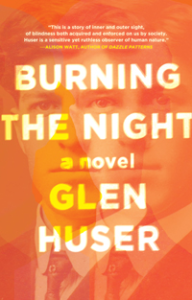Burning The Night – Questions & Activities
 Books | About the Book | Synopsis | Questions & Activities
Books | About the Book | Synopsis | Questions & Activities
1. In some ways this is a “doubly historical” novel with parts set in 1916-1917 and other parts ranging over the 1950s to the 1970s. In contrast to our current time, what details are distinctive to these periods? Are there some aspects that resonate with today’s world?
2. Major Canadian cities serve as settings from sequence to sequence—Edmonton, Vancouver, Toronto, and Halifax in particular. Do you feel the author captured distinct features of each? Anything missing?
3. What parallels do you see in Phillip’s and Curtis’s lives? How does Curtis shape his life to fit the Phillip who emerges from journal entries and Aunt Harriet’s remembrances?
4. Through much of the novel, Curtis reveals himself as extremely shy and unaccepting of his sexuality. Projecting from the 1960s/1970s to the 2020s, do you think a Curtis growing up today would have been more comfortable with himself? Would Walter have been any different in today’s social environment?
5. “Negative space” is a term artists use in composition; one that Curtis employs with his junior high art club. How does the term expand as a metaphor for other things happening (or not happening) in the novel?
6. We discover that Harriet can be unreliable in recounting some of her experiences. How do other characters in the novel cover for her—and serve to foster Curtis’s unblinking acceptance of her stories?
7. Although there are hints early on about what happened to Phillip and Harriet in December, 1917, why do you think the author chose to use the closing chapters of the book to detail the Halifax Explosion?
8. When did you first learn about the Halifax Explosion? Do you think this is an incident not very well known outside of Canada (and possibly unknown by many Canadians)?
9. How does music resonate throughout the novel? Were you spurred to track down and listen to any of the classical pieces mentioned? Which do you think would best serve as a musical accompaniment for the “Love Has Me Haunted” poem that prefaces the novel?
10. Canadian art is another crucial strand in the narrative. What was distinctive about the landscape art of Tom Thomson and the Group of Seven? Is there any resolution today about the mystery of Thomson’s death?
11. If you were to cast a movie of Burning the Night, what actors would you pick to play: Curtis; Walter; Aunt Harriet; Harriet as a young woman; Phillip Pariston; Per; Edwina; Radcliffe Malthus; Tom Thomson; Carroll Carmody; Moira Greckel; Curtis’s mother
